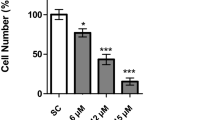Abstract
Thousands of gallons of industrial chemicals, crude 4-methylcyclohexanemethanol (MCHM) and propylene glycol phenyl ether (PPh), leaked from industrial tanks into the Elk River in Charleston, West Virginia, USA, on January 9, 2014. A considerable number of people were reported to exhibit symptoms of chemical exposure and an estimated 300,000 residents were advised not to use or drink tap water. At the time of the spill, the existing toxicological data of the chemicals were limited for a full evaluation of the health risks, resulting in concern among those in the impacted regions. In this preliminary study, we assessed cell viability and plasma membrane degradation following a 24-h exposure to varying concentrations (0–1000 μM) of the two compounds, alone and in combination. Evaluation of different cell lines, HEK-293 (kidney), HepG2 (liver), H9c2 (heart), and GT1-7 (brain), provided insight regarding altered cellular responses in varying organ systems. Single exposure to MCHM or PPh did not affect cell viability, except at doses much higher than the estimated exposure levels. Certain co-exposures significantly reduced metabolic activity and increased plasma membrane degradation in GT1-7, HepG2, and H9c2 cells. These findings highlight the importance of examining co-exposures to fully understand the potential toxic effects.










Similar content being viewed by others
Abbreviations
- (MCHM):
-
4-methylcyclohexanemethanol
- (PPh):
-
Propylene glycol phenyl ether
References
Adams, C., Whelton, A., & Rosen, J. (2014). Literature review: Health effects for chemicals in 2014 West Virginia chemical release: crude MCHM compounds, PPH and DiPPH. Charleston: West Virginia Testing Assessment Project.
Banks, W.A. (2009). Characteristics of compounds that cross the blood-brain barrier. BMC Neurology, S3.
Christie, R. D., Gross, A. E., & Fortin, R. J. (1990). Process for coal flotation using 4-methyl cyclohexane methanol frothers. US Patent US4915825. Nalco Chemical Company.
Cooper, W. J. (2014). Responding to crisis: the West Virginia chemical spill. Environmental Science & Technology, 48, 3095.
Dietrich, A. M., Thomas, A., Zhao, Y., Smiley, E., Shanaiah, N., Ahart, M., Charbonnet, K. A., DeYonker, N. J., Alexander, W. A., & Gallagher, D. L. (2015). Partitioning, aqueous solubility, and dipole moment data for cis- and trans-(4-methylcyclohexyl)methanol, principal contaminants of the West Virginia chemical spill. Environmental Science & Technology Letters, 2(4), 123–127.
Dow Chemical Company (2012). Propylene glycol phenyl ether; Technical Data Sheet, Dow Chemical Company.
Eastman Chemical Company. (2015). Crude MCHM; MSDS. Kingsport: Eastman Chemical Company.
Eastman Kodak Company, (1990). Acute toxicity of 4-methylcyclohexane methanol. Available: http://www.eastman.com/Pages/Eastman-Crude-MCHM-Studies.aspx (Accessed March 22, 2016).
Green, D.R., Galluzzi, L. & Kroemer, G. (2014). Metabolic control of cell death. Science, 345(6203).
Lan, J., Hu, M., Gao, C., Alshawabkeh, A., & Gu, A. Z. (2015). Toxicity assessment of 4-methyl-1-cyclohexanemethanol and its metabolites in response to a recent chemical spill in West Virginia, USA. Environmental Science & Technology, 49, 6284–6293.
Lobner, D. (2000). Comparison of the LDH and MTT assays for quantifying cell death: validity for neuronal apoptosis? Journal of Neuroscience Methods, 96, 147–152.
Mosmann, T. (1983). Rapid colorimetric assay for cellular growth and survival: application to proliferation and cytotoxicity assays. Journal of Immunological Methods, 65(1–2), 55–63.
NTP (National Toxicology Program). (2014). West Virginia chemical spill: NTP research project plan. (Accessed February 18, 2016)
OECD, 2004. Propylene glycol phenyl ether. Organisation for Economic Co-operation and Development Screening Information Dataset Initial Assessment Report for 18 SIAM UNEP Publications. http://www.inchem.org/documents/sids/sids/770354.pdf
Paustenbach, D. J., Winans, B., Novick, R. M., & Green, S. M. (2015). The toxicity of crude 4-methylcyclohexanemethanol (MCHM): review of experimental data and results of predictive models for its constituents and a putative metabolite. Critical Reviews Toxicology, 45(Suppl 2), 1–55.
Petiot, E., Jacob, D., Lanthier, S., Lohr, V., Ansorge, S., & Kamen, A. A. (2011). Metabolic and kinetic analyses of influenza production in perfusion HEK293 cell culture. BMC Biotechnology, 11, 84.
Roe, A. L., Snawder, J. E., Benson, R. W., Roberts, D. W., & Casciano, D. A. (1993). HepG2 cells: an in vitro model for P450-dependent metabolism of acetaminophen. Biochemical and Biophysical Research Communications, 190, 15–19.
Taatjes, D. J., Sobel, B. E., & Budd, R. C. (2008). Morphological and cytochemical determination of cell death by apoptosis. Histochemistry and Cell Biology, 129(1), 33–43.
Whelton, A. J., McMillan, L., Connell, M., Kelley, K. M., Gill, J. P., White, K. D., Gupta, R., Dey, R., & Novy, C. (2015). Residential tap water contamination following the Freedom Industries chemical spill: perceptions, water quality, and health impacts. Environmental Science & Technology, 49, 813–823.
WV DHHR, (2014). West Virginia Department of Health and Human Resources: Elk River Chemical Spill Health Effects Findings of Emergency Department Record Review.
Author information
Authors and Affiliations
Corresponding author
Rights and permissions
About this article
Cite this article
Han, A.A., Fabyanic, E.B., Miller, J.V. et al. In vitro cytotoxicity assessment of a West Virginia chemical spill mixture involving 4-methylcyclohexanemethanol and propylene glycol phenyl ether. Environ Monit Assess 189, 190 (2017). https://doi.org/10.1007/s10661-017-5895-5
Received:
Accepted:
Published:
DOI: https://doi.org/10.1007/s10661-017-5895-5




